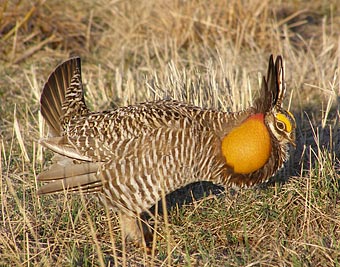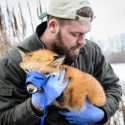Watching the birds: Agri-tourism could help save colorful prairie chicken
In terms of entertaining courtship rituals, few animals can hold a candle to Tympanuchus cupido — the drummer of love, commonly known as the greater prairie chicken.

Greater prairie chicken.
Photo: Lesa Skuldt, Wisconsin Department of Natural Resources
To win the attention of a mate, male prairie chickens inflate their vibrant orange throat sacs and strut around with pinnae standing up like feathery horns, a comical display that has won the birds legions of fans. During the birds’ spring mating season, some enthusiasts huddle for hours before dawn to catch a glimpse of the chickens in action.
But for University of Wisconsin–Madison researchers David Drake and Ashly Steinke, the birds’ unusual behavior represents an opportunity — one that could help preserve the chickens’ threatened population and benefit area farmers at the same time.
Once prevalent in every Wisconsin county, prairie chickens have been on the state’s threatened species list since 1979, as fragmentation and degradation of the birds’ native habitat has reduced their population to an estimated 1,200 birds. Drake, an assistant professor of wildlife ecology, is taking part in a five-year project to expand their numbers, which involves transporting chickens from Minnesota to help broaden their genetic diversity.
But that’s only part of the solution, he says. The birds need more habitat where they can mate and intermingle.
And that’s where Wisconsin farmers come in. During the birds’ mating season — usually marked by the annual Central Wisconsin Prairie Chicken Festival, which this year takes place April 18-20 — some farmers offer deals that allow nature lovers to watch the birds’ rituals on their land. Typically, bird-watchers arrive in the pre-dawn hours, huddling behind plywood blinds to take in the birds’ display.
"You get in the blind at 4:30 a.m., and it’s still dark, and the birds are already there," says Carl Flaig, who last season allowed the state Department of Natural Resources to place two blinds on his land. "And you start hearing the booming. The sun is coming up, it’s an incredible experience."
Flaig says he and his wife, Carol, enjoyed the experience so much that they’re expanding to four blinds this year. The couple now offers group tour packages that include an evening Chuckwagon meal and stargazing, the early-morning prairie chicken dance, and a home-cooked farm breakfast.
It’s exactly this kind of collaboration that Drake envisions helping restore the birds’ population in the state. Drake and Steinke, one of his graduate students, are working to survey farmers and landowners to gauge interest in managing some land as grassland habitat for the birds.
"We want to try and diversify the farm," Drake says, "to allow farmers to manage for grasslands on their properties and to offer them economic opportunities like bird watching."
It can be a win-win situation, he says, offering entrepreneurial farmers such as Flaig a chance to earn some extra income while also creating an essential habitat corridor. "If you can save the prairie chicken," Drake says, "you can save other grassland associated species as well."



